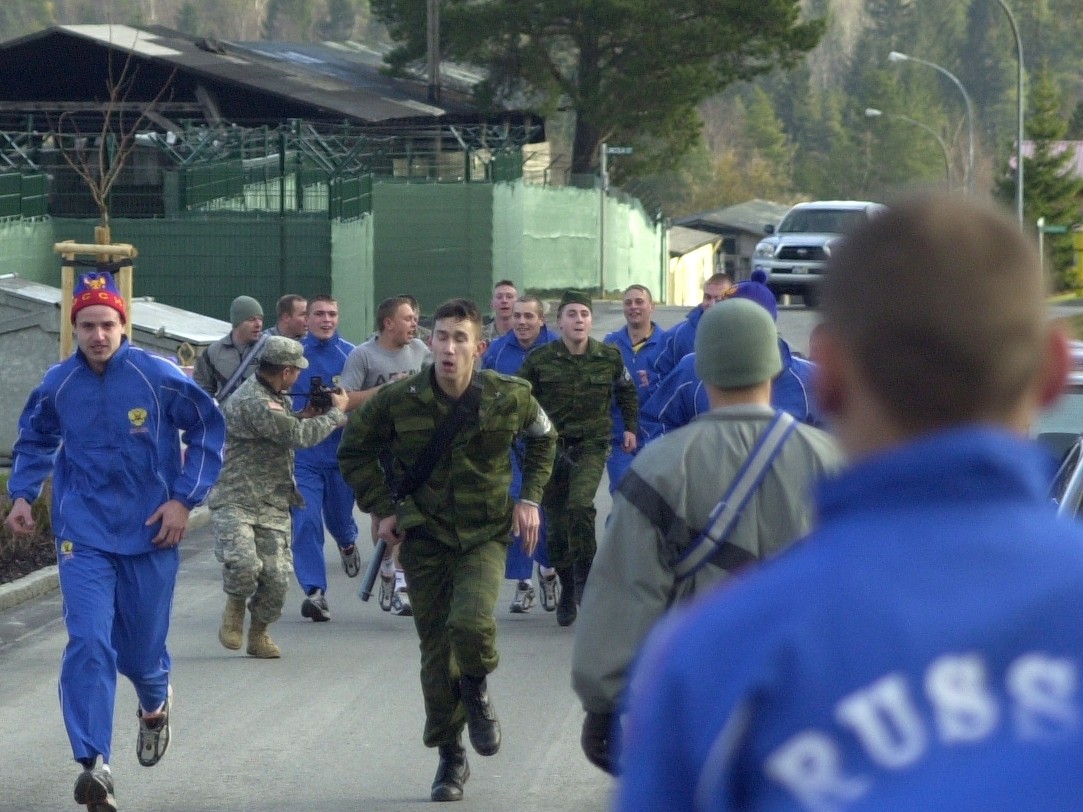
HEIDELBERG, Germany (Army News Service, Dec. 10, 2007) - U.S. and Russian soldiers are training together this week in an exercise named "Torgau" in remembrance of the place where the two armies first met in Germany during World War II.
Training will take place at Germany's Grafenwoehr and Hohenfels training areas. More than 180 Russian soldiers are expected to take part this year, training with members of the V Corps staff in Grafenwoehr for a command post exercise and with troops from the 1st Battalion, 4th Infantry Regiment for combined exercises in Hohenfels, Germany.
One of the first events of the exercise was a 8 "cultural day" Dec. at the Hohenfels Training Area. The event required participants to run two miles, fire M16 rifles on a live range, then run two miles back to the start point. The two-week exercise will also include combined basic infantry skills training and culminate in a combined live-fire exercise.
This year's exercise is the third since the Torgau "series" began in 2004. Last year's exercise was cancelled.
The exercise shows the two countries are committed to fostering cooperation, collaboration and improved interoperability, said Lt. Col. Kevin M. Volk, exercise division branch chief for U.S. Army Europe's operations directorate.
"They're able to learn how we think, and likewise we're able to learn how they think and how they do business," he said. "It's a great chance to strengthen our relationship with the Russians."
That spirit of cooperation is said to date back to April 25, 1945 when V Corps' 273rd Infantry Regiment was chasing remnants of the German army. When the unit approached the Elbe River in the small town of Torgau, the Soldiers saw something unexpected - men in Soviet uniforms. Troops from the two armies came together to shake hands.
Since 2004, the two armies have commemorated that day in a joint exercise that rekindles the sentiment of camaraderie both armies felt more than 60 years ago.
Maj. Leslie L. Balfaqih, an exercise planner in the USAREUR operations directorate, said fluid interoperability can lead to two goals: positive military and political relations and an increased probability of success if the two countries join to combat a common foe.
"In the event we operate with them, we're on the same page," Maj. Balfaqih said.
She explained that the command post exercise in in Grafenwoehr will join the two forces' staff officers for training on simulated scenarios focusing on four areas: stability, support, transition and reconstruction. At the same time, U.S. and Russian Soldiers will join together at Hohenfels for situational exercises including simulated urban operations and improvised explosive device training, before capping the two-week event with a live-fire exercise.
Although the U.S.-Russian military relationship is not yet as cultivated as those between the U.S. and its NATO partners, Lt. Col. Volk said, USAREUR officials hope events such as Torgau will help the alliance between the two forces mature.
Planning an international exercise the magnitude of Torgau has not been easy, Lt. Col. Volk explained: the two armies have conducted planning conferences to work out the thousands of "moving pieces" the exercise entails and to try to predict any problems that might crop up. During the conferences, planners from both sides worked together to organize and coordinate training, logistics, command and control procedures, and even spoken and written translations that ensure any information that comes from one side can be understood by the other.
In the case of an exercise such as Torgau, planning and execution are further complicated by political sensitivities, Lt. Col. Volk said.
For example, the most recent conference took place near the end of September in Mulino, Russia. Lt. Col. Volk said the meeting was a historic milestone in its own right, as it marked the first time members of a foreign defense force had been allowed into Mulino. But when these planning forums close, he added, the two militaries communicate any further needs through their respective embassies. The complexity of this inter-embassy communication pushes both sides to resolve the bulk of their issues at the planning conferences, he added.
Lt. Col. Volk said the focus for Torgau each year is on learning valuable lessons that will yield dividends not only for future combined exercises, but for both militaries as a whole.
"The work that we get done together as two military forces sows the seeds for future cooperation between our two countries," he said.
(Spc. Joseph McAtee writes for the U.S. Army Europe Public Affairs Office.)

Social Sharing